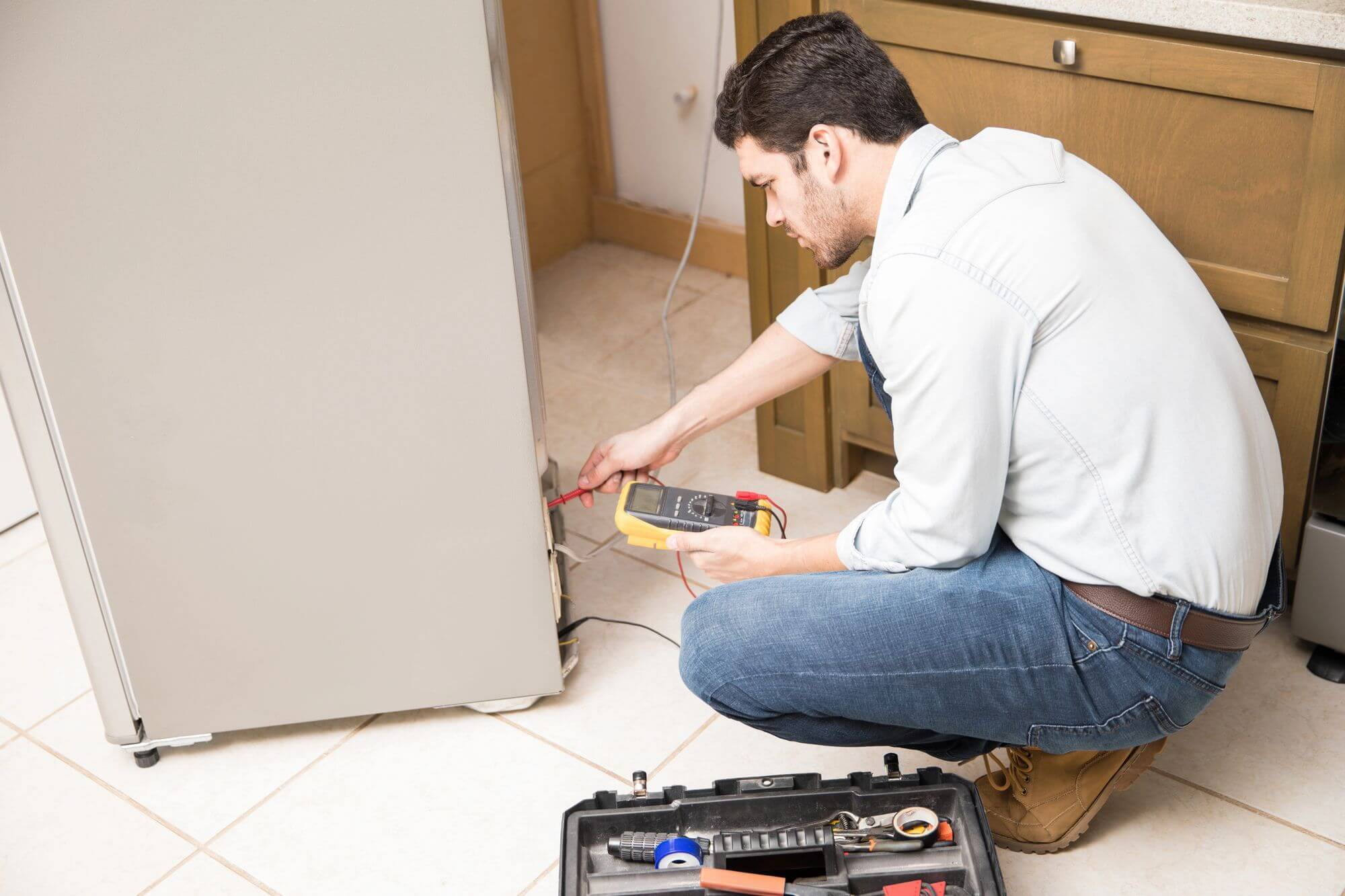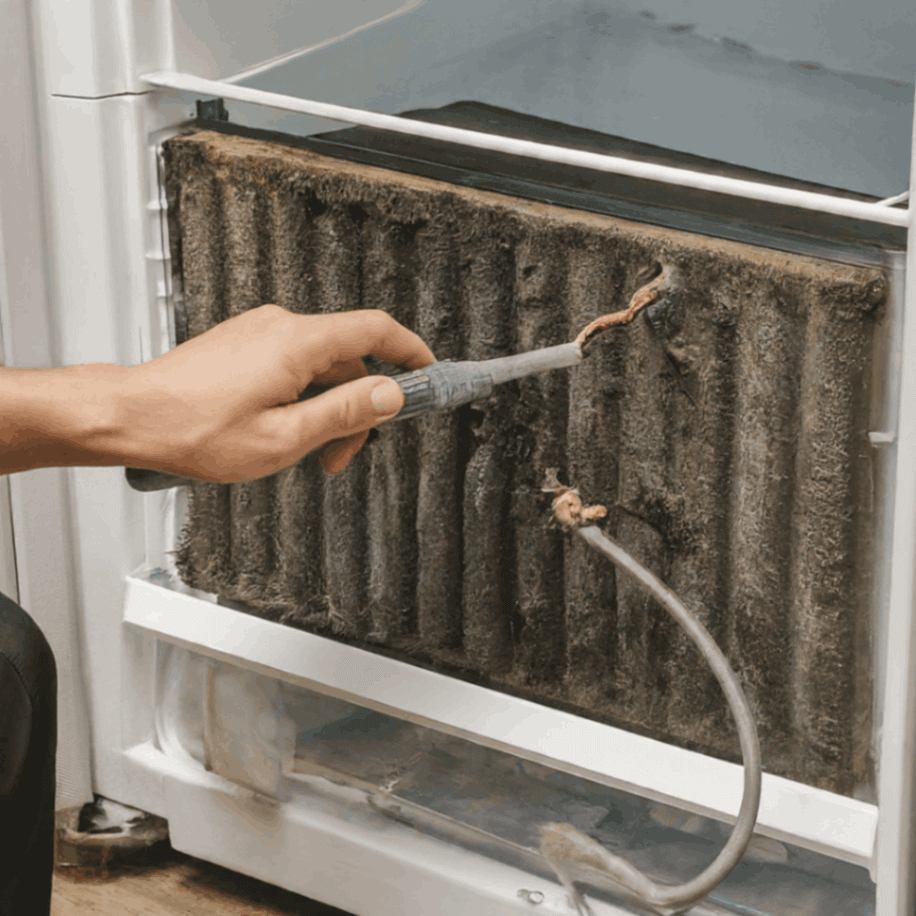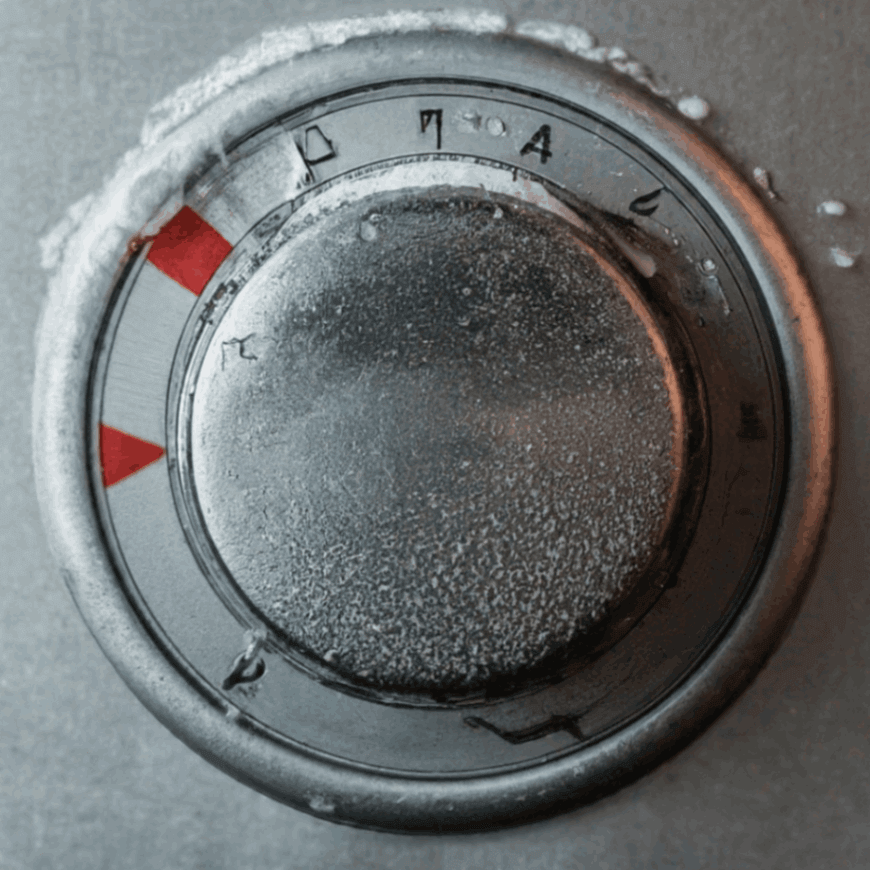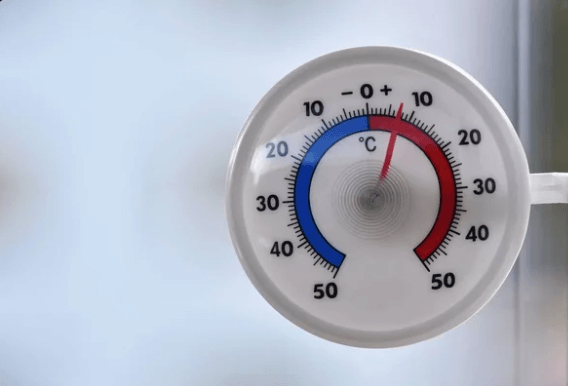 Last updated: August 23rd, 2024
Last updated: August 23rd, 2024
The Top 4 Reasons Why Your Refrigerator Is Not Cooling

A refrigerator is an essential appliance in any household, and when it stops cooling correctly, it can cause a significant disruption. Food spoilage, wasted groceries, and the inconvenience of malfunctioning appliances are all frustrating issues. If your refrigerator is not cooling, understanding the possible reasons behind this problem is the first step toward finding a solution.
Understanding Why Your Refrigerator Is Not Cooling
Here are the four primary reasons why your refrigerator may not be cooling. Learn how to spot them and the DIY solutions in this section. Let’s get started!
Reason #1: Dirty Condenser Coils

Condenser coils are located either at the back or underneath the refrigerator. They dissipate heat from the fridge into the surrounding air, helping to keep the interior cool. Over time, however, these coils can become clogged with dust, pet hair, and other debris, preventing them from releasing heat efficiently. This forces the refrigerator to work harder to maintain the desired temperature, which can result in inadequate cooling.
Signs Of Dirty Condenser Coils
- Burnt Smell: You might detect a faint burnt smell from the compressor overheating due to dirty condenser coils.
- Musty Odor: Accumulated dirt and debris can lead to musty or moldy odors around the back or bottom of the refrigerator.
- Warm To The Touch: The sides or back of the refrigerator may feel excessively warm or hot, indicating that the heat is not being dissipated effectively through the condenser coils.
- Louder Operation: The refrigerator may produce louder than usual operational noises, as the compressor and fans work harder to compensate for the reduced cooling efficiency.
- Short Cycling: The compressor might turn on and off frequently, indicating that it works harder than necessary due to the lack of efficient heat dissipation.
How To Fix It
To clean the condenser coils, follow these steps:
- Unplug The Refrigerator: Ensure the refrigerator is turned off and unplugged to avoid electrical hazards.
- Locate The Coils: Depending on the model, the coils are located at the back or bottom of the refrigerator.
- Clean the Coils: Use a vacuum cleaner with a brush attachment to remove dust and debris. A coil cleaning brush can be effective for stubborn dirt.
- Regular Maintenance: Aim to clean the coils every six months to a year to prevent future issues
Reason #2: Faulty Evaporator Fan Motor

The evaporator fan motor is responsible for circulating air over the evaporator coils and throughout the refrigerator and freezer compartments. This circulation is essential for maintaining a consistent and evenly distributed temperature inside the appliance.
Signs Of A Faulty Evaporator Fan Motor
- Unusual Noises: Grinding, squealing, or clicking sounds from the freezer compartment can indicate a problem with the fan motor.
- Warm Refrigerator Compartment: If the freezer is still cold but the refrigerator compartment is warm, the fan may not be circulating air properly.
- Frost Build-Up: Excessive frost on the evaporator coils or in the freezer compartment indicates poor air circulation.
- Increased Energy Bills: A refrigerator running constantly due to a faulty fan motor can lead to higher energy consumption.
How To Fix It
To address a faulty evaporator fan motor:
- Unplug the Refrigerator: Ensure safety by disconnecting the appliance from the power source.
- Locate the Fan Motor: This is usually in the freezer compartment behind the rear panel.
- Test the Motor: Use a multimeter to check for continuity. If there’s no continuity, the motor needs to be replaced.
- Replace the Motor: Remove the faulty motor and install a new one. Reassemble the freezer compartment and plug the refrigerator back in.
Reason #3: Malfunctioning Thermostat

The thermostat controls the temperature inside the refrigerator by regulating the compressor and evaporator fan motor. A faulty thermostat may not accurately sense the temperature, causing the compressor and fan to cycle intermittently. This can lead to the refrigerator being too warm or too cold.
Signs Of A Malfunctioning Thermostat
- Inconsistent Temperature: The temperature inside the refrigerator fluctuates significantly, resulting in food that is either too cold or too warm.
- Refrigerator Runs Continuously: The refrigerator runs constantly without cycling off, leading to excessive noise and higher energy bills.
- Freezer Section Frost Build-Up: If the thermostat is not working properly, the evaporator coils may become excessively cold, accumulating frost in the freezer compartment.
How To Fix It
To diagnose and replace a malfunctioning thermostat:
- Unplug the Refrigerator: Always start by disconnecting the power.
- Locate the Thermostat: This is usually found inside the refrigerator compartment.
- Test the Thermostat: Turn the thermostat from the lowest to the highest setting. Listen for a clicking sound, indicating it’s working. If there’s no click, use a multimeter to check for continuity.
- Replace the Thermostat: If it’s faulty, remove the old thermostat and install a new one.
- Test the Refrigerator: Plug the refrigerator back in and set the thermostat to the desired temperature to ensure it operates correctly.
Reason #4: Low Refrigerant Levels

Refrigerant is a fluid that absorbs heat from the refrigerator’s interior and releases it outside, keeping the inside cool. If there’s a leak or the refrigerant levels are low, the refrigerator won’t be able to absorb and release heat effectively, resulting in poor cooling performance.
Signs Of Low Refrigerant Levels
- Inefficient Heat Exchange: Low refrigerant levels disrupt this cycle. The evaporator coils may not get cold enough, leading to inadequate cooling and higher temperatures inside the refrigerator.
- Frost Buildup: Excessive frost can block the airflow in the refrigerator, making it difficult to maintain consistent cooling and further reducing efficiency.
- Oil Residue: Look for oily residue or stains around the evaporator or condenser coils. These can indicate a refrigerant leak, which often carries oil from the compressor.
- Hissing or Bubbling Sounds: If there is a refrigerant leak, you might hear hissing or bubbling noises from the refrigerator. These sounds are caused by the refrigerant escaping from the system.
How To Fix It
If you notice any of the signs mentioned above, it is crucial to address the issue promptly:
- Professional Diagnosis: Contact a certified refrigerator technician to diagnose the problem accurately. They have the tools and expertise to check refrigerant levels and identify leaks.
- Repair Leaks: If a leak is found, the technician will repair it to prevent further refrigerant loss.
- Recharge Refrigerant: The technician will recharge the system with the appropriate type and amount of refrigerant, restoring the refrigerator’s cooling efficiency.
- Regular Maintenance: Schedule regular maintenance checks to ensure your refrigerator operates efficiently and to catch potential issues early.
Why Is It Necessary To Take Actions Quickly?
Call a professional or fix the issue promptly if you notice any of the signs mentioned above. Otherwise, you may end up facing the following problems:
1. Food Spoilage
- Perishable items like dairy, meat, and fresh produce can spoil quickly if they are not kept at the appropriate temperature.
- Spoiled food means discarding items more frequently, leading to waste and additional grocery expenses.
- Continuously buying replacement food items can add up, impacting your budget.
- Moreover, consuming spoiled food can lead to foodborne illnesses, posing severe health risks to you and your family.
2. Higher Energy Bills
- When a refrigerator struggles to cool, the compressor runs more frequently or continuously, consuming more energy.
- This increased energy use leads to higher utility bills, affecting your monthly budget.
- The constant operation can prematurely wear out the refrigerator’s components, such as the compressor and fans.
3. Potential Appliance Damage
- The compressor may overheat due to constant operation, leading to potential burnout and costly repairs.
- Continuous strain can shorten the overall lifespan of the refrigerator, necessitating an earlier-than-expected replacement.
- Inefficient cooling can cause frost or ice buildup on the evaporator coils, blocking airflow and further reducing cooling efficiency.
- In severe cases, you may need to replace the entire refrigerator, which is a significant investment.
4. Negative Environmental Impact
- Higher energy consumption results in a larger carbon footprint, contributing to environmental degradation.
- Inefficient appliances waste natural resources used for electricity generation, impacting sustainability efforts.
How Can You Save On Addressing Cooling Issues?
By following these simple tips, you can help prevent future cooling problems with your refrigerator:
1. Regular Maintenance
- Ensure condenser coils are clean and free of debris.
- Inspect door seals for damage or wear and replace them if necessary.
- Maintain proper space around air vents.
- Keep the door closed as much as possible.
- Don’t put hot food directly into the refrigerator.
2. Monitor Temperature
- Ensure the refrigerator and freezer are set to the manufacturer’s recommended temperatures.
- Use a refrigerator thermometer to verify internal temperatures.
3. Consider A Home Warranty
- A home warranty typically covers the cost of repairs and replacements for major appliances, including refrigerators. This can save you from paying out-of-pocket for expensive repairs.
- Instead of facing unexpected significant expenses, you typically pay a set service fee or deductible, often much lower than the cost of a significant repair or replacement.
- Many home warranty providers offer guarantees on repairs, giving you peace of mind that if the problem recurs, it will be addressed without additional costs.
Top 3 Home Warranty Companies For Your Refrigerator
A malfunctioning refrigerator can be a significant inconvenience, leading to spoiled food and a race against time to save your groceries. This is why you must consider a home warranty that can provide peace of mind by covering repairs or replacements for your refrigerators. Here’s a quick comparison of the top 3 home warranty companies to help you choose the one that best suits your needs.
Premium
$29 - $89
Deductible
$100 & $125
Coverage Limit
$4K - $5K
Why We Picked It
- AHS is an industry leader with a vast network of 17,000 qualified technicians and a strong reputation for customer service.
- Monthly pricing starts around $29 (varies depending on location and plan).
- The company offers three plans—ShieldSilver, ShieldGold, and ShieldPlatinum—with coverage up to $4,000 for refrigerators, including repairs and replacements for mechanical parts and components.
$200 Off + 2 Months Free + Free Roof Leak Protection
Premium
$50 - $60
Deductible
$90
Coverage Limit
$2K/Item
Why We Picked It
- LHG is known for its high consumer ratings and a nationwide network of over 10,000 certified technicians.
- Pricing begins at $49 per month for the Appliance Guard plan, which covers refrigerators and varies depending on location and plan.
- It covers all mechanical parts and components of your kitchen refrigerator, freezer, and ice maker. In addition, LHG offers 42 add-on coverage options, allowing you to customize your plan to fit your specific needs.
$50 off + 1 Month Free
Premium
$46 - $55
Deductible
$75 - $125
Coverage Limit
Upto $3K/item
Why We Picked It
- CHW is a budget-friendly option with straightforward plans and easy-to-understand coverage details.
- Their monthly premiums start around $46, depending on location and plan.
- Choice offers two plans, while the Total plan covers repairs and replacements for all refrigerator components and integral freezers.
Conclusion
A refrigerator not properly cooling can be due to various reasons, but regular maintenance can help prevent some of these issues. However, for more complex problems like refrigerant leaks, professional help is essential. By understanding the common causes, you can take the appropriate steps to restore your refrigerator to optimal performance and keep your food fresh.
related articles
 Discover First American Home Warranty Locations and What You Need to Know About Their Cover.
Discover First American Home Warranty Locations and What You Need to Know About Their Cover.
 Reviews of Home Warranty Companies Show You How to Determine If Your Home Is Covered
Reviews of Home Warranty Companies Show You How to Determine If Your Home Is Covered













